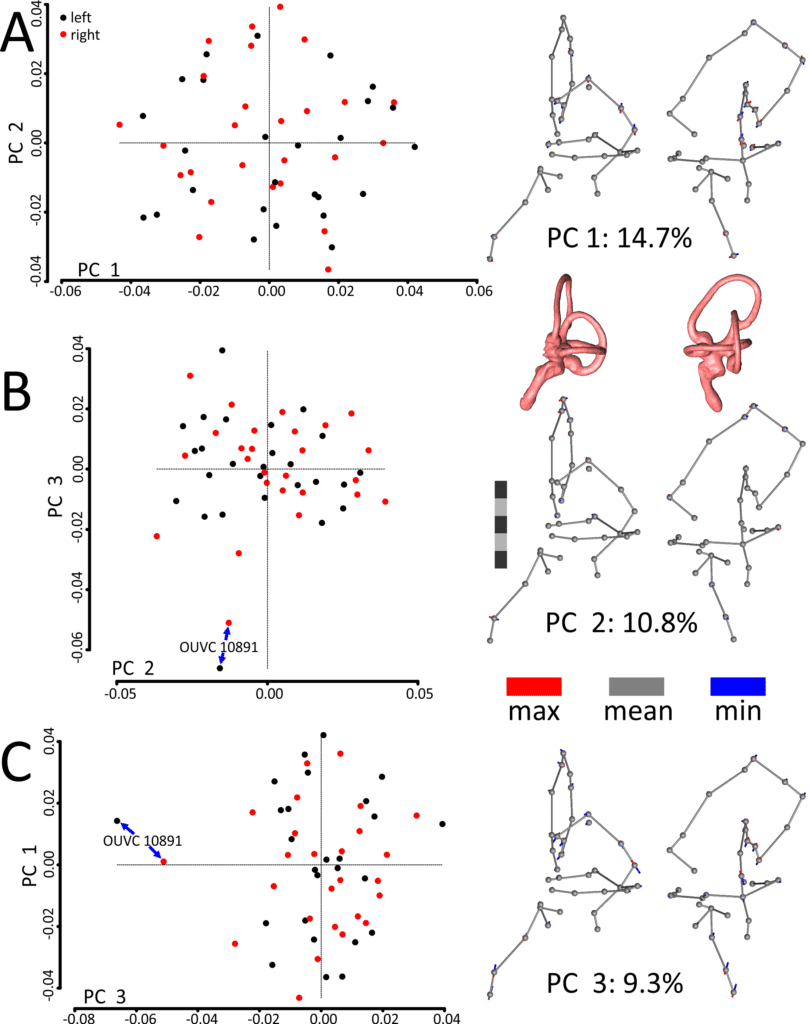Donald G. Cerio, PhD

- BA, Cornell University, Ithaca, NY
- PhD, Ohio University, Athens, OH
- Ohio University Heritage College of Osteopathic Medicine, Athens, OH
Special Projects

Anatomy of the soft tissues of the orbits of diapsids
The eyes of vertebrates have enjoyed a long history of study. However, the spatial relationships between the bony orbit, eyeball, and adnexal tissues–like extraocular muscles, lubricating glands, and sunshade devices–is not as well-understood in reptiles and birds. These structures, many of which are critically important for the function of the visual system, also take up space in the orbit and potentially constrain the size, shape, and orientation of the eyeball. This part of my work is focused on shedding light on these spatial relationships.
Selected Publications
Degrange FJ, Cerio DG, Tambussi CP, Ridgely RC, and LM Witmer. In preparation. Building a terror bird: evolutionary trade-offs between the visual system and cranial biomechanics in a clade of extinct cursorial predatory birds (Aves, Cariamiformes). Nature.
Early CM, Cerio DG, Porter WR, Ridgely RC, and LM Witmer. In preparation. The skull and neurosensory system of the extinct giant moa, Dinornis robustus (Aves, Palaeognathae) with implications for the behavioral role of vision in moa. Anatomical Record.
Gignac PM, Kley NJ, Clarke JA, Colbert MW, Morhardt AC, Cerio D, Cost IN, Cox PG, Daza JD, Early CM, Echols MS, Henkeleman RM, Herdina AN, Holliday CM, Li Z, Mahlow K, Merchant S, Müller J, Orsbon CP, Paluh DJ, Thies ML, Tsai HP, and LM Witmer. 2016. Diffusible iodine-based contrast-enhanced computed tomography (diceCT): an emerging tool for rapid, high-resolution, 3-D imaging of metazoan soft tissues. Journal of Anatomy 228(6):889-909.

The vestibuloocular reflex of diapsids: anatomical correlates and evolutionary implications
The semicircular canals of the inner ear are functionally linked to the extraocular muscles through the vestibuloocular reflex, which can be thought of as a process that stabilizes gaze. Evidence from the literature suggests these two structures may also be spatially or geometrically linked. Since the semicircular canals tend to fossilize well, these are structures that could provide key pieces of evidence for restoring soft tissues of the visual apparatus of extinct species. This part of my research is aimed at quantifying the shape of the bony inner ear, or endosseous labyrinth, in a sample of wild turkeys. In particular, I am assessing the symmetry of left and right ears and disparity in shape among the sample of ears.

Scatterplots and ball-and-stick visualizations of the first three principal components (PCs) of the shape variation in inner-ear labyrinths from a sample of wild turkeys from Ohio. http://dx.doi.org/10.7717/peerj.7355

Virtual Ophthalmoscopy
Visual fields are commonly tested in human ophthalmology. They are frequently used to determine whether and how a disease has led to a pathological loss of vision. Recent research in the comparative literature has shown that the spatial disposition of visual fields–like the size and shape of the binocular area, or the orientation of the optic axis–is correlated with other aspects of morphology and ecology.
To apply this to extinct species, I developed and validated a novel workflow to predict visual fields, using a combination of anatomy, geometrical optics, phylogenetic statistics, and 3D visualization.

Graphical summary of Virtual Ophthalmoscopy, a novel workflow invented by Dr. Cerio for modeling visual fields for modern and extinct taxa in silico, using a barn owl as an example. https://doi.org/10.1016/j.visres.2019.11.007
News
Monday, 12/4/23: Dr. Chet Sherwood, Bodian Seminar
2023 SURGICAL ILLUSTRATION PRESENTATION
Congratulations!!!
We want to announce the arrival of a new FAE-by, Eddie Foster, who was born recently to Mary and Will...a hearty and warm congrats to the three of you!
